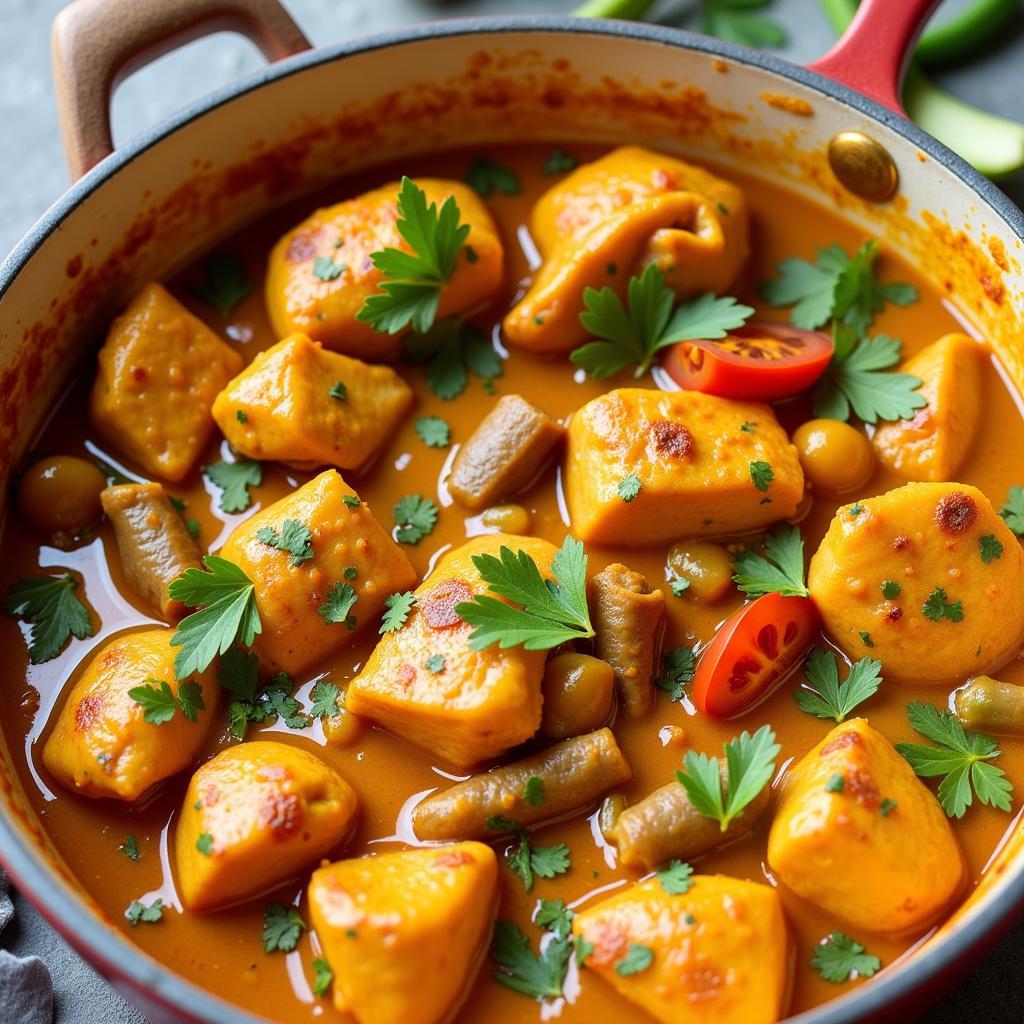Low Fodmap Indian Food doesn’t have to be a distant dream. With a little knowledge and some clever substitutions, you can enjoy the vibrant flavors of India without the digestive distress. This guide will walk you through the ins and outs of creating delicious, gut-friendly Indian meals that are as satisfying as they are easy on your stomach.
Navigating the Spice Route: Understanding Low FODMAP Indian Food
Indian cuisine is renowned for its complex spice blends and rich flavors, but some of these ingredients can be high in FODMAPs. FODMAPs are a group of carbohydrates that can trigger digestive issues for those with IBS or other sensitivities. However, with careful ingredient selection and preparation, you can still enjoy a wide variety of Indian dishes. Key to low FODMAP Indian food is understanding which spices are high in FODMAPs and which ones are safe to use liberally. Garlic and onion, staples in many Indian recipes, are unfortunately high in FODMAPs.
Luckily, many flavor-packed spices are low in FODMAPs. Ginger, turmeric, cumin, coriander, and garam masala can be used generously to build a flavorful base for your dishes. Asafoetida, a pungent spice with a garlicky aroma, can be used sparingly as a substitute for onion and garlic. A pinch goes a long way! This allows you to recreate the depth of flavor found in traditional Indian cooking while keeping your meals low FODMAP.
Building Your Low FODMAP Indian Plate
Creating a balanced and flavorful low FODMAP Indian meal involves choosing the right ingredients for each component of your dish. Let’s explore some options:
Low FODMAP Vegetables for Indian Cooking
Many vegetables are naturally low in FODMAPs and work beautifully in Indian dishes. Consider incorporating spinach, carrots, eggplant (skin removed), green beans, and butternut squash into your meals. These vegetables provide essential nutrients and add texture and color to your dishes.
Protein Powerhouses for Low FODMAP Indian Cuisine
Protein is an important part of any balanced meal. Chicken, fish, tofu, and tempeh are all excellent low FODMAP protein options that pair well with Indian flavors. Be sure to marinate your protein using low FODMAP spices and herbs for maximum flavor.
 Low FODMAP Indian Chicken Curry
Low FODMAP Indian Chicken Curry
Grains and Legumes: Choosing Wisely for Low FODMAP
When it comes to grains and legumes, it’s essential to choose low FODMAP options. White rice, quinoa, and canned lentils (rinsed thoroughly) are good choices. Avoid high FODMAP options like chickpeas and kidney beans. You might also enjoy browsing our comfort food recipe book.
Dairy Delights: Low FODMAP Options
While many dairy products are high in FODMAPs, there are some alternatives you can use to achieve that creamy texture in your Indian dishes. Lactose-free milk, coconut milk, and almond milk can be used as substitutes for regular milk or cream.
Creating a Flavorful Low FODMAP Indian Feast
Now that you understand the basics, let’s put it all together. Here are some tips for creating a satisfying and gut-friendly Indian meal:
- Start with a low FODMAP base: Use ginger, turmeric, cumin, coriander, and garam masala to create a flavorful foundation.
- Add low FODMAP vegetables: Incorporate vegetables like spinach, carrots, and eggplant.
- Choose the right protein: Opt for chicken, fish, tofu, or tempeh.
- Select appropriate grains and legumes: Stick to white rice, quinoa, and canned lentils (rinsed).
- Use low FODMAP dairy alternatives: Opt for lactose-free milk, coconut milk, or almond milk.
“When crafting low FODMAP Indian meals, focus on fresh, whole ingredients and experiment with different spice combinations to find your favorites,” advises renowned dietitian, Dr. Anya Sharma. “Don’t be afraid to get creative and make the dishes your own.”
Conclusion
Low FODMAP Indian food is entirely achievable with a bit of planning and knowledge. By choosing the right ingredients and using creative substitutions, you can enjoy the vibrant flavors of India without compromising your digestive health. Explore the delicious world of low FODMAP Indian cuisine and discover a whole new level of culinary satisfaction. For those interested in exploring Indian food further, check out our indian food without onion and garlic article.
FAQ
- What are the most common high FODMAP ingredients in Indian food? Onion, garlic, chickpeas, kidney beans, and certain dairy products.
- What can I use as a substitute for onion and garlic in Indian cooking? Asafoetida powder is a great substitute, used sparingly.
- Can I eat naan bread on a low FODMAP diet? Traditional naan bread is often high in FODMAPs. Look for gluten-free and low FODMAP alternatives.
- Are all Indian spices low FODMAP? No, some spices like onion and garlic powder are high in FODMAPs. Stick to spices like ginger, turmeric, cumin, coriander, and garam masala.
- What are some good low FODMAP vegetable choices for Indian dishes? Spinach, carrots, eggplant (skin removed), green beans, and butternut squash are great options.
- What type of rice is best for a low FODMAP diet? White rice is a safe option. Brown rice is moderately high in FODMAPs and should be limited.
- Where can I find more low FODMAP Indian recipes? Check out our fodmap indian food page for more ideas.
Here are some other questions that you might find helpful:
- What are some simple low FODMAP Indian recipes for beginners?
- How can I adapt my favorite Indian recipes to be low FODMAP?
- Are there any pre-made low FODMAP Indian sauces or spice blends available?
You might also be interested in our article on true food cauliflower recipe and our resource on little flower food pantry.
When you need support, please contact us via Phone: 02437655121, Email: minacones@gmail.com Or visit us at: 3PGH+8R9, ĐT70A, thôn Trung, Bắc Từ Liêm, Hà Nội, Việt Nam. We have a 24/7 customer service team.